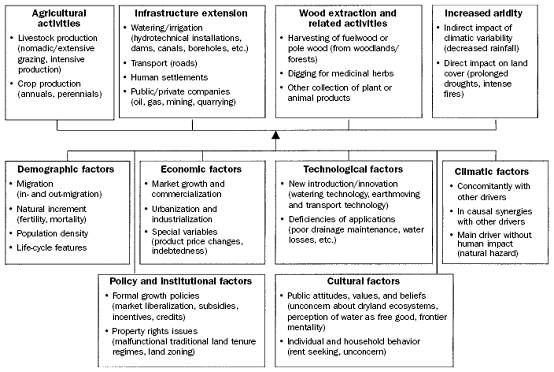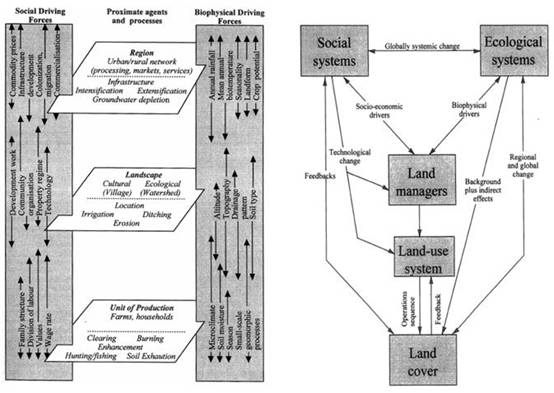Biophysical and socio-economic causes
There is a great deal of debate amongst scientists as to whether the causes of desertification should be sought in the socio-economic or the biophysical sphere, and on the degree to which these causes are local or remote and how variables interact across organizational levels in different regions in the world and during different time periods (Lambin et al., 2002; Reynolds and Stafford Smith, 2002; Geist and Lambin, 2004). However, most authors (e.g. Turner et al., 1995; Puigdefábregas, 1998; Geist and Lambin, 2004) agree that there is not one single factor that causes desertification or land degradation. Both biophysical and socio-economic factors should be considered, even jointly, as they interact and reinforce each other to induce transition trigger events (Turner et al, 1995; Puigdefábregas, 1998). Related to this is the issue that it is often difficult or even impossible to separate natural from human-induced degradation. In many cases, climate or climatic change acts as a boundary condition, but without human actions this would not necessarily lead to degradation. Disturbances, connected with transition triggers and due to change in, for example, climate, soil, social, cultural and economic factors, can drive environments prone to drought and exploited by humans to desertification. The disturbances, then, are such that boundary conditions are changed and the system is overexploited (i.e. it is driven beyond its resilience thresholds) (Puigdefábregas, 1998). This latter notion, however, suggests that any ecosystem, prone to desertification was in a state of equilibrium in the past (i.e. before the disturbances). However, there are also models of non-equilibrium that argue that there may in fact be multiple equilibrium points (Hutchinson et al., 2005). This is a separate, though interesting discussion point not central to this review. The reader is referred to papers such as Folke (2006) and references therein.
In the literature, many processes are named that contribute to desertification: from overgrazing and improper management of irrigation, to political pressure, urbanization and climatic hazards. In two studies (Turner et al., 1995 and Geist and Lambin, 2004), the causes of land use/cover change and desertification are discussed in a general way. They illustrate the complexity and interrelationships of drivers of desertification. Both studies recognize both biophysical and socio-economic causes. Geist and Lambin (2004) combine biophysical and social drivers in their 'underlying driving forces' (see Fig. 3.1).
In many studies (e.g. UNEP, 1997; Lambin et al., 2001) the view that one factor, such as population or poverty acts as the underlying cause of land degradation is rejected. Geist and Lambin (2004) analyzed 132 subnational case studies on the causes of dryland degradation to determine whether the proximate causes (human activities of immediate actions at the local level, e.g. cropland extension) and underlying driving forces (fundamental social and biophysical processes, e.g. agricultural policies or human population dynamics (see Fig. 3.1)) fall into any pattern and to identify mediating factors and feedback mechanisms that may lead to typical pathways of dryland degradation. They suggest multiplicity as the most common theme reported in the case studies they analysed. The complexity is accounted for by system dynamics, according to the authors, with special emphasis on the initial conditions and adaptation of the system, the heterogeneity of the actors, the hierarchical levels of organisation and the non-linear dynamics caused by feedback mechanisms. Above this the complexity is associated with a limited number of typical pathways that lead to desertification (Geist and Lambin, 2004; see section 3.2).

Fig. 3.1: Causes of desertification: six clusters of underlying driving forces underpinning the proximate causes of desertification (from: Geist and Lambin, 2004; Geist, 2005).
Turner et al. (1995) focus on land use and land cover change. The driving forces recognized by them, however, are applicable to the desertification issue as well, as change in land use/cover may lead to degradation and desertification. They state that the relative dynamics of interacting forces should be recognized, as variables appearing as drivers at one scale, may seem constant at another. Over and above this, feedback effects are possible at another scale than the driving force (Turner et al., 1995). For example, the aggregate effect of groundwater withdrawal from individual wells may be a general desiccation of the landscape.
Turner et al. recognize three dimensions of drivers relevant to land use/cover change (See Fig. 3.2): socio-economic, biophysical and land management (proximate causes), which then can be put in cultural and historical context at various scales.

Fig. 3.2: Multi-scale driving forces in land use/cover change (left); and framework for understanding land cover changes (right) (from: Turner et al., 1995).